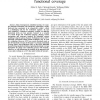PROCEDIA
2010
14 years 3 months ago
2010
High performance computing with low cost machines becomes a reality with GPU. Unfortunately, high performances are achieved when the programmer exploits the architectural specific...
108
click to vote
SIES
2010
IEEE
14 years 6 months ago
2010
IEEE
Abstract--Many heterogeneous embedded systems, for example industrial automation and automotive applications, require hard-real time constraints to be exhaustively verified - which...
MEMOCODE
2010
IEEE
14 years 6 months ago
2010
IEEE
Monitoring temporal SystemC properties is crucial for the validation of functional and transaction-level models, yet the current SystemC standard provides no support for temporal s...
EMSOFT
2010
Springer
14 years 6 months ago
2010
Springer
SystemC is the de facto standard for modeling embedded systems. It allows system design at various levels of abstractions, provides typical object-orientation features and incorpo...
DAC
2010
ACM
14 years 7 months ago
2010
ACM
As high-level models in C and SystemC are increasingly used for verification and even design (through high-level synthesis) of electronic systems, there is a growing need for com...
SIMVIS
2004
14 years 9 months ago
2004
We present a rigorous formal - but transparent - specification of the semantics of a generic simulation-based 3D animation framework. Our system combines a SystemC simulation kern...
FM
2008
Springer
14 years 10 months ago
2008
Springer
TLM (Transaction-Level Modeling) was introduced to cope with the increasing complexity of Systems-on-Chip designs by raising the modeling level. Currently, TLM is primarily used fo...
CODES
2008
IEEE
14 years 10 months ago
2008
IEEE
SystemC is widely used for modeling and simulation in hardware/software co-design. Due to the lack of a complete formal semantics, it is not possible to verify SystemC designs. In...
142
click to vote
FDL
2004
IEEE
15 years 3 days ago
2004
IEEE
gn process of embedded systems moves currently towards higher levels of abstraction. As a consequence, a need arises for an early and realistic assessment of system level design d...
ISCAS
2003
IEEE
15 years 1 months ago
2003
IEEE
To handle today’s complexity, modern circuits and systems be specified at a high level of abstraction. Recently, SystemC has been proposed as a language that allows a fast on o...




